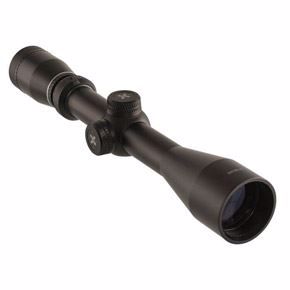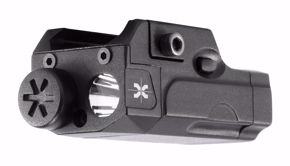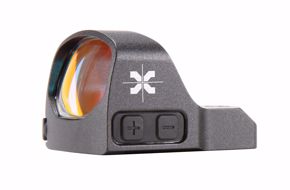Axeon® Optics has released a crazy simple device that takes all of the guesswork and frustration out of sighting in a rifle. The Absolute Zero is comprised of two lasers that you attach to your scope while sighting it in. It works in as little as one shot. All of the headache is gone, and you will save time and money getting on target. I’ve had one to test out, and I’m impressed with its simplicity.
First, though, let’s define the necessity. Why do we need a new way to sight in?
If you have sighted in a rifle, you know what I mean by “walking it in.” That’s how I describe my process. I set up a target at 25 yards, brace my rifle, put the crosshairs on the bulls-eye and fire a shot. I then look back through the scope.
Next, comes the estimation and the clicking. I try to move the crosshairs to the bullet hole. This isn’t easy, as the rifle inevitably moves when I tweak the turrets. So then I line it up, fire again. Hopefully, the point of impact is closer to the bull’s-eye. Do it again.
Some rifles I can sight in with a minimal amount of firing and tweaking. Others, not so much. And shooting that many rounds can get expensive. As a gun writer, I’m often sighting in .45-70s, and .338 Lapuas, and even .50 BMGs. I hate wasting ammo on those.
How to Sight In with the Absolute Zero
Let’s begin with the promise of simplicity. The Absolute Zero is being advertised as the most foolproof way to sight in ever. All it takes is one shot at 25 yards. If you then want to zero at 100, you can fire another shot at 100 yards. How does the magic work?
The concept really is simple. First, think of a typical laser on a rifle or a handgun. The point of the laser on the target should approximate point of impact for the bullet. Many people rely on the concept for self-defense alone. But one laser is not terribly useful for sighting in a scope, as it won’t show if the rifle moves.
The Absolute Zero isn’t meant to stay on your rifle while you are shooting or hunting. It isn’t that kind of laser. Instead, it simplifies the sighting in process. The two lasers work with a third point of impact, your bullet’s hole in the target, to form three steady reference points.
It begins with the installation on the gun. Simply attach the laser unit to the tube of your scope.
The lasers will shine downrange. The kit comes with a reference grid—a reflective strip that helps bounce back the refracted laser light, making it easier to see, even in sunlight.
You will need to orient the strip with your lasers. If they’re vertical on the scope, be sure your reflective grid is on the same side, and in the same orientation.
The grid is numbered. When you secure the rifle in a good shooting rest, or even on a sandbag, you will be able to position the lasers on the grid. Remember which numbered sections you are looking at.
Now look to the crosshairs. When everything is safe and clear down-range, fire one shot. Hold as steady as you can. Recoil will likely bounce the rifle up and you’ll lose the original placement on the grid. No worries. That’s why you have two lasers, and that’s why the grid is numbered.
Re-center. This is the part that is really much easier. Get the rifle set in the rest again, with the lasers on the same spots. If you are shooting off a bag, have a helper who can assist with dialing the scope. Watch the lasers. When they are set, dial your crosshairs to the bullet hole.
If you want to fire a proof shot at this point, you can. Ignore the lasers. Simply find a mark on the target and pull the trigger. You should be zeroed perfectly.
At 100 yards, this 25-yard zero will still be in the kill-zone of most North American game animals. For example, the 150 grain .308s I sighted in hit just over 3 inches high at 100 yards. Where I hunt in Arkansas, I rarely get sight distances over 200 yards, so that 25-yard zero would suffice.
If you want to be dead on at 100, move a target out to that distance and move back to the bench. Place the crosshairs on the bulls-eye, steady everything, and pull the trigger.
Your 25-yard shot takes care of the left/right up/down basics. The 100-yard shot, which is on a standard scale of Minute of Angle clicks on nearly every scope, will just require the simple raising of the crosshairs. It is entirely possible to be dead-on at 100 yards with only two shots fired.
I dialed the crosshairs up 12 clicks and fired a second shot and hit dead on.
Helpful Tips for Sighting In
Shoot a clean target. I’m a sucker for a white poster board. It is stiff enough that the bullets punch and large enough that I’m not going to miss, even with a gun with no sights. A nice clean target cuts down on the bullet holes.
Remember that you don’t need a bulls-eye at first; you sight into the hole you shoot. The less clutter on the paper, the better.
Keep things steady. Poor marksmanship is easy to hide at 25 yards. Take things out to 100 yards, though, and you will begin to separate those who know how to shoot from those who watch too many movies. Mind your trigger. Watch your breathing. Hold firm, but let the rifle move how it wants to. All of these basics translate into accuracy at 100 yards. And errors, even simple ones, will make you miss by a mile.
Look at your sunlight. Most gun ranges won’t let you turn around and shoot in the opposite direction. Keep in mind that lasers aren’t as easy to see in bright sunlight, or through scopes with no magnification. A spotting scope could be useful, too. If not a spotting scope, try binoculars.
Get plenty of rest. A good bench rest is going to make this that much easier. I often shoot at a range that has lovely concrete benches and tables. They’re immovable objects. A lead sled on one of these is a fine option.
Don’t be afraid of the math. Know some basics. How high is your scope over your bore? That will change the holdover at 100, 200, etc. Be confident with the basics, like average drop rates at the big distances, and you’ll shoot much more confidently. Axeon® has actually done quite a bit of research for you in this department. They have posted a ballistics chart on their website for many popular calibers and several popular loads in each caliber. This chart also accounts for scope bore axis height in the ballistics for those rounds.
If you don’t have that option, and many of us don’t, you just need to practice form even more carefully. Belly out with your rifle on a good sandbag, or on a stable duffel bag. Put a piece of protective foam on a rock if you have to. The ABSOLUTE ZERO is meant to be easy to use, and the dual laser reference points perfect that. But you have to hold the lasers steady until the bullet leaves the barrel, and then again when adjusting the scope.
How You Can Make Sighting In More Complicated
I’m going to be blunt. This is an amazingly accurate system. If you gave it to a robot, the process would be perfect. We are not robots.
The ABSOLUTE ZERO isn’t foolproof. We all know the fools I’m talking about. Human error will defeat this system, easily. Let’s take a look at how.
First, the mount has to be secure. The tube mount is easy enough to use, but don’t over-tighten it. But make sure that your Absolute Zero is tightened down like crazy on the pic mount. The scope has to be securely mounted on the rifle. And the rifle really does have to be steady during the scope calibration.
You should also be using ammunition with known ballistics. Be sure you have two of the same type of rounds on hand if you’re shooting at 100. And know what you like to shoot with. Your zero with light, low recoil .308 would not be the same if you switched to really hot hog-killing, hard-nosed bullets. Keep things consistent.
And, as always, play it safe. Keep your rifle unloaded while installing the Absolute Zero. These are lasers so don’t stare at them. And cut the unit off when you are finished. You should get more than 32 hours of run time, enough to sight in a battalion’s worth of rifles, but not if you don’t shut it down.
Axeon® is working on a polymer-based unit that will attach to a barrel. The unit I have, and the first on the market, has a zinc alloy body. While it is as solid as a tank, if it were mounted to the barrel, it could change the barrel harmonics on a thinner rifle barrel. The result could be a tweak in accuracy that you wouldn’t see when using the scope mounted AZ.
And a side note. You could also use the ABSOLUTE ZERO on a rifle with iron sights, especially at 25 yards. If you are working in an AR, or any rifle with modular sights, this could be an easy way to get on paper. Line up the gun in the rest as you usually would, line up your lasers on the reference grid, and fire a round.
David Higginbotham is a writer and educator who lives in Arkansas. After years of writing and consulting in the firearms industry, he's coming back to his roots with air guns.



